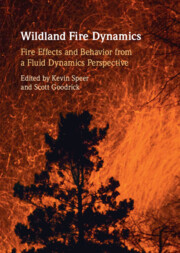Book contents
- Wildland Fire Dynamics
- Wildland Fire Dynamics
- Copyright page
- Contents
- Contributors
- 1 Wildland Fire Combustion Dynamics
- 2 The Structure of Line Fires at Flame Scale
- 3 Energy Transport and Measurements in Wildland and Prescribed Fires
- 4 Fire Line Geometry and Pyroconvective Dynamics
- 5 Firebrands
- 6 Re-envisioning Fire and Vegetation Feedbacks
- 7 Wind and Canopies
- 8 Coupled Fire–Atmosphere Model Evaluation and Challenges
- Index
- References
2 - The Structure of Line Fires at Flame Scale
Published online by Cambridge University Press: 16 June 2022
- Wildland Fire Dynamics
- Wildland Fire Dynamics
- Copyright page
- Contents
- Contributors
- 1 Wildland Fire Combustion Dynamics
- 2 The Structure of Line Fires at Flame Scale
- 3 Energy Transport and Measurements in Wildland and Prescribed Fires
- 4 Fire Line Geometry and Pyroconvective Dynamics
- 5 Firebrands
- 6 Re-envisioning Fire and Vegetation Feedbacks
- 7 Wind and Canopies
- 8 Coupled Fire–Atmosphere Model Evaluation and Challenges
- Index
- References
Summary
We present a discussion of the structure of line fires, a canonical configuration in wildland fire research. This configuration allows detailed studies of the effects of wind and sloped terrain on heat transfer and fire spread mechanisms at flame scale. We emphasize in the discussion the existence of two limiting flame regimes in line fires: the plume-dominated regime, in which the flame is detached from the ground, and the wind or slope-driven regime, in which the flame is attached to that surface. These two regimes correspond to dramatically different flame structures, flow patterns, modes of heat transfer, and flame spread mechanisms. The transition between the two flame regimes is discussed in terms of critical values of Byram's convection number or slope angle. We limit our discussion to a simplified configuration corresponding to gas-fueled flames. Hence the heat release rate of the flame is controlled and the flame is non-spreading; difficulties associated with real wildland fuel are left out of the discussion. The structure of the line fires is discussed through results from high-resolution simulations of laboratory-scale flames based on a large eddy simulation (LES) approach. Additional insight is also obtained through a scaling analysis based on an integral model.
Keywords
- Type
- Chapter
- Information
- Wildland Fire DynamicsFire Effects and Behavior from a Fluid Dynamics Perspective, pp. 35 - 62Publisher: Cambridge University PressPrint publication year: 2022



